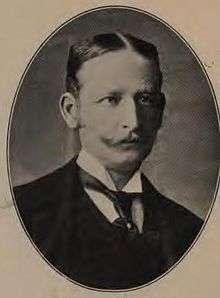Frederick Banbury, 1st Baron Banbury of Southam
| Frederick Banbury, 1st Baron Banbury of Southam | |
|---|---|
 Banbury in 1895 | |
| Born | 2 December 1850 |
| Died | 13 August 1936 |
| Education | Winchester College |
| Occupation | Aristocrat, businessman, politician |
| Spouse(s) | Elizabeth Rosa Beale |
| Parent(s) |
Frederick Banbury Cecilia Laura Cox |
Frederick George Banbury, 1st Baron Banbury of Southam PC (2 December 1850 – 13 August 1936), known as Sir Frederick Banbury, 1st Baronet, from 1903 to 1924, was a British businessman and Conservative Member of Parliament.[1]
Early life
Frederick Banbury was born on 2 December 1850. He was the eldest son of Frederick Banbury and Cecilia Laura (née Cox) of Shirley House Surrey.,[2] and was educated at Winchester College.[2]
Business career
Banbury was admitted to the London Stock Exchange in 1872[2] and was head of Frederick Banbury and Sons, stockbrokers, of London, between 1879 and 1906, as well as chairman of the Great Northern Railway (GNR) and a director of the London and Provincial Bank.[1][2]
Politics
Banbury was elected to represent Camberwell, Peckham in the House of Commons at the 1892 general election, and held the seat in 1895 and 1900. At the 1906 general election he lost the seat as the Liberal Party won a large majority.[2] Later in the year he returned to parliament when he was returned unopposed in a by election for the City of London.[2] He held the seat until 1924.[1]
He was a diligent member of the Commons, and was known for his formal attire and punctuality. Although he remained on the back benches he was regarded as an institution in the House.[2] Banbury was created a baronet, "of Southam in the County of Warwick", in 1903,[3] and admitted to the Privy Council in 1916.[1]
After his retirement from the House of Commons in 1924 he was raised to the peerage as Baron Banbury of Southam, of Southam in the County of Warwick.[1][4]
Railways
He was the last chairman of the GNR, which lost its identity when, under the Railways Act 1921, it was grouped with several other railways on 1 January 1923 to become a constituent of the London and North Eastern Railway (LNER). Sir Frederick was a strong opponent of the railway grouping, and had voted against the Bill during its passage through Parliament; he wanted no part of the future LNER, and decided to retire from railway service at the end of 1922.[5] In late September 1922, the GNR honoured Sir Frederick by naming its newest express passenger locomotive no. 1471 Sir Frederick Banbury. This locomotive belonged to GNR Class A1, was built in July 1922 and remained in service until November 1961.[6]
Personal life
Banbury married Elizabeth Rosa, daughter of Thomas Barbot Beale, of Brettenham, Suffolk in 1873.[1] She died in 1930.[1] Banbury survived her by six years and died in August 1936 at his home, Warneford Place, Highworth, Wiltshire aged 85. He was buried in Sevenhampton.[2] He was succeeded in the barony by his grandson Charles, his only son Captain Charles William Banbury having been killed in the First World War.[1]
Banbury was an animal lover, and for years was on the council of the Royal Society for the Prevention of Cruelty to Animals, and served as its chairman.[2]
Notes
- 1 2 3 4 5 6 7 8 "BANBURY of Southam, 1st Baron". Who Was Who. Oxford University Press. December 2007. Retrieved 27 May 2011.
- 1 2 3 4 5 6 7 8 9 "Obituary: Lord Banbury A Parliamentary "Character"". The Times. 14 August 1936. p. 14.
- ↑ The London Gazette: no. 27500. p. 8366. 2 December 1902.
- ↑ The London Gazette: no. 32900. p. 684. 22 January 1924.
- ↑ Hughes 1987, pp. 9,12
- ↑ Groves 1992, pp. 89,98,99
References
- Groves, Norman (1992). Great Northern Locomotive History: Volume 3b 1911-1922 The Gresley Era. Lincoln: RCTS. ISBN 0-901115-70-3.
- Hughes, Geoffrey (1987) [1986]. LNER. London: Guild Publishing/Book Club Associates. CN 1455.
Sources
- Kidd, Charles, Williamson, David (editors). Debrett's Peerage and Baronetage (1990 edition). New York: St Martin's Press, 1990,
- Leigh Rayment's Peerage Pages
- Leigh Rayment's Historical List of MPs
- Lundy, Darryl. "FAQ". The Peerage.
External links
| Wikisource has the text of a 1922 Encyclopædia Britannica article about Frederick Banbury. |
- Hansard 1803–2005: contributions in Parliament by Lord Banbury of Southam
| Parliament of the United Kingdom | ||
|---|---|---|
| Preceded by Arthur Anthony Baumann |
Member of Parliament for Peckham 1892 – 1906 |
Succeeded by Charles Goddard Clarke |
| Preceded by Sir Edward George Clarke Arthur Balfour |
Member of Parliament for the City of London 1906 – 1924 With: Arthur Balfour 1906–1922 Edward Grenfell 1922–1924 |
Succeeded by Edward Grenfell Sir Thomas Vansittart Bowater |
| Baronetage of the United Kingdom | ||
| New creation | Baronet (of Southam) 1903 – 1936 |
Succeeded by Charles William Banbury |
| Peerage of the United Kingdom | ||
| New creation | Baron Banbury of Southam 1924 – 1936 |
Succeeded by Charles William Banbury |